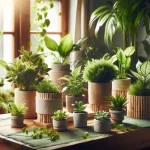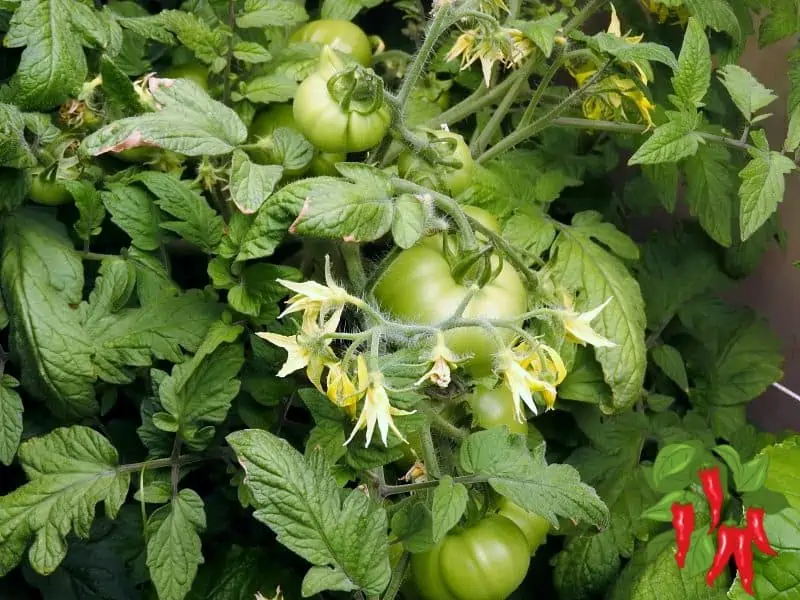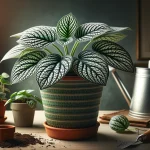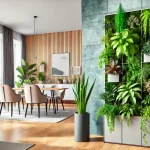This post may contain affiliate links. If you buy something from one of our links we may earn a commission. Thanks
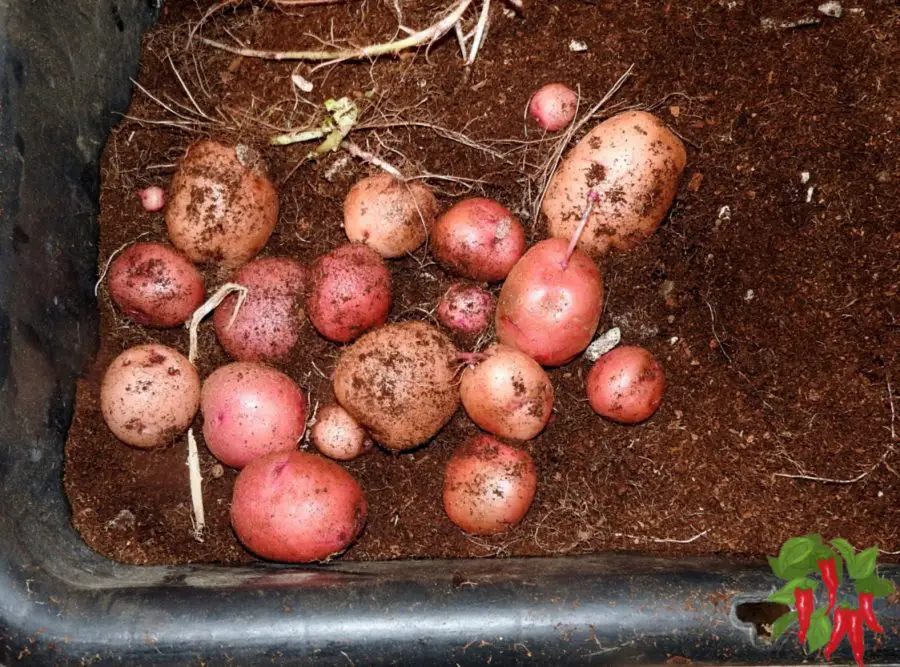
Growing red potatoes in containers is easier than you might think! Ever wanted fresh spuds but don’t have a big garden?
No worries – with just a bucket, some soil, and a bit of know-how, you can grow tasty potatoes right on your porch or even indoors. Let me show you how!
Growing Red Potatoes in Containers Key Takeaways
- Growing red potatoes in containers is a space-efficient method for home gardeners.
- Start with a large container (at least 5 gallons) filled with well-draining potting mix like coco coir.
- Plant one seed potato for a 5 gallon bucket.
- Plant it 4-6 inches deep and water regularly.
- As plants grow, add more soil to cover the stems.
- Harvest when foliage turns yellow.
 5 LBS – Red Norland Potato Seed – Non GMO – Naturally Grown
5 LBS – Red Norland Potato Seed – Non GMO – Naturally Grown
Growing Red Potatoes in Containers Indoors: A Step-by-Step Guide
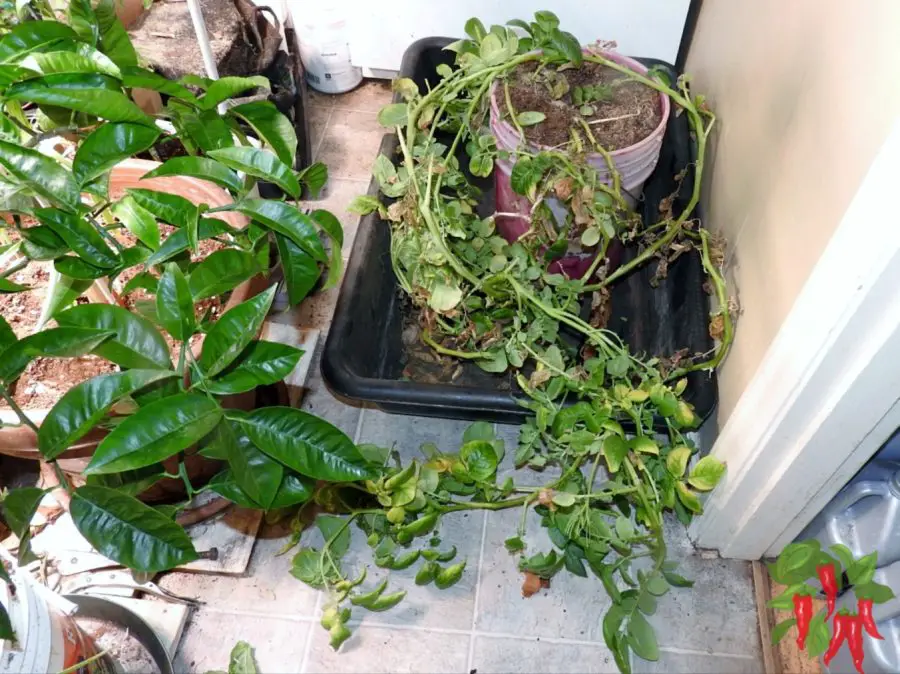
Hey there, fellow gardeners! Today we’re talking about growing red potatoes in containers indoors.
If you’re like me and love fresh spuds but don’t have a big yard, this guide is for you.
I’ve been growing veggies indoors for years, and I’m excited to share what I’ve learned about container potato farming. Let’s dig in!
Why Grow Potatoes in Containers?
Growing potatoes in containers is a game-changer for small-space gardeners. When I moved to an apartment, I thought my potato-growing days were over.
Boy, was I wrong! Container gardening opened up a whole new world of possibilities. Here’s why you might want to give it a try:
Save Space
If you’re short on outdoor space, containers are your best friend. You can grow potatoes on a balcony, patio, or even indoors near a sunny window. I’ve got a thriving potato plant right in my kitchen!
Keep Pests Away
Container growing helps you avoid common garden pests like voles and wireworms. Trust me, after years of battling these critters in my outdoor garden, the peace of mind is worth it.
Easy Harvesting
No more digging up half your yard to find those hidden spuds. When it’s harvest time, just dump out your container and collect your bounty. It’s that simple!
Choosing the Right Potato Variety for Containers
Picking the right potato variety can make a big difference in your container gardening success. Here’s what you need to know:
Red Norland Potatoes
Red Norlands are great for containers because they mature quickly and don’t need tons of space. They’re my go-to for early harvests.
I got 2.28 pounds from my 5-gallon bucket.
Other Good Options
If you want to branch out, try Yukon Gold, Fingerling, or Purple Potatoes. These varieties often give higher yields in containers. I’ve had great luck with Yukon Golds in my indoor setup.
A Word on Grocery Store Potatoes
I know it’s tempting to plant that sprouted potato from your pantry, but resist! Grocery store potatoes can carry diseases. Stick with certified seed potatoes for the best results.
Selecting the Best Container for Growing Potatoes
Your container choice can make or break your potato-growing success. Here’s what to look for:
Size Matters
Aim for a container that’s at least 5-gallons and a foot deep. Potatoes need room for their roots to spread out. I once tried growing in a shallow pot and ended up with tiny potatoes!
Material Options
You’ve got choices here. Fabric grow bags, plastic tubs, and even old barrels can work. I prefer using 5-gallon buckets.
There are 10-gallon fabric potato grow bags that should work equally well.
 5-Pack 10 Gallon Potato Grow Bags, Garden Planting Bag with Reinforced Handle
5-Pack 10 Gallon Potato Grow Bags, Garden Planting Bag with Reinforced Handle
Drainage is Key
Whatever container you choose, make sure it has good drainage. Drill some holes in the bottom if you need to.
I used a bucket with holes drilled in the bottom and placed it in a second bucket to catch any runoff.
Growing Potatoes Indoors: Special Considerations
Growing potatoes indoors comes with its own set of challenges. Here’s how to set yourself up for success:
Let There Be Light
Potatoes need lots of light. If you don’t have a super sunny spot, consider using grow lights. I use Spiderfarmer SF 2000 LED lights for my indoor potato plants and they work great.
 Spider Farmer SF2000, Samsung LM301H EVO Led Grow Light, Full Spectrum Plant Grow Light, 200W Dimmable & High Efficiency
Spider Farmer SF2000, Samsung LM301H EVO Led Grow Light, Full Spectrum Plant Grow Light, 200W Dimmable & High Efficiency
Temperature Control
Potatoes like it cool, but not cold. Aim for soil temperatures between 60-70°F. I keep a thermometer in my potting mix to make sure it’s just right.
 4-in-1 Soil Moisture Meter Digital PH Meter/Soil Moisture/Plant Temperature/Sunlight Intensity
4-in-1 Soil Moisture Meter Digital PH Meter/Soil Moisture/Plant Temperature/Sunlight Intensity
Air Flow is Important
Good air circulation helps prevent mold and rot. If the air is still use a small fan near your indoor plants to keep the air moving.
Step-by-Step Guide to Planting Red Potatoes in Containers
Ready to get planting? Here’s how to do it:
1. Prepare Your Seed Potatoes
Cut larger seed potatoes into pieces, making sure each chunk has at least one “eye.” Let them dry for a day or two before planting. I prefer one medium potato with eyes.
2. Fill Your Container
I use straight coco coir but you can use a potting soil mix too. I like to add some slow-release fertilizer too. Fill your container about a third of the way.
3. Plant Your Potatoes
Place your seed potato in about 6 inches of soil with the eyes facing up. Cover them with 3-4 inches of soil. You only need one potato for a 5-gallon bucket.
4. Hill Your Potatoes
As your plants grow, keep adding soil to cover the stems. This encourages more potato growth. I add a couple of inches of soil every week or so.
I did not do this with my current grow. All the potatoes were near the top of the bucket. I think my yield would have been better if I had hilled them.
Care and Maintenance
Taking good care of your potato plants will help ensure a good harvest. Here’s what to do:
Watering Schedule
Keep the soil moist but not waterlogged. I water my container potatoes every few days, or when the top inch of soil feels dry.
Feeding Your Plants
Potatoes are hungry plants! I use an organic fertilizer every few weeks to keep them happy.
Keep on Hilling
Continue adding soil as your plants grow. This protects developing potatoes from light and encourages more tubers to form.
Common Problems When Growing Potatoes Indoors
Indoor potato growing can come with some challenges. Here’s what to watch out for:
No Natural Dieback
Unlike outdoor plants, indoor potatoes won’t naturally die back to signal harvest time. I look for yellowing leaves as a sign it’s time to check for mature spuds.
Crowded Containers
Overcrowding can lead to smaller yields. Don’t try to cram too many plants into one container. I stick to 1 plant in a 5-gallon container.
Indoor Pests
Keep an eye out for fungus gnats and mold. Good air circulation and avoiding overwatering can help prevent these issues.
Watch out for bugs like aphids or spider mites. Use neem oil for insect pests.
Harvesting Potatoes from Containers
The moment of truth – harvest time! Here’s how to know when and how to harvest your container potatoes:
When to Harvest
For new potatoes, you can start harvesting when the plants flower. For mature potatoes, wait until the foliage starts to yellow and die back.
How to Harvest
Gently tip your container over and sift through the soil to find your potatoes. Be careful not to bruise them. It’s like a treasure hunt!
Troubleshooting and Tips for Better Yields Next Time
If your first attempt wasn’t perfect, don’t worry! Here are some tips for your next potato-growing adventure:
Choose Higher-Yield Varieties
If your yield was disappointing, try a variety known for container production next time. I’ve had great results with Yukon Gold in containers.
Extend Your Growing Season
With indoor growing, you can plant potatoes year-round. Try staggering your plantings for a continuous harvest.
Try different varieties to find what grows best for you.
FAQs About Growing Potatoes in Containers
Hey there, potato lovers! I’ve gotten a bunch of questions about growing spuds in containers, so I thought I’d put together this handy FAQ.
Whether you’re a newbie or just looking to up your potato game, these answers should help you out. Let’s dig in!
Q. Can I Grow Potatoes Indoors Year-Round?
A. You bet! With the right setup, you can grow potatoes indoors any time of year. Just make sure they get enough light – a sunny window or grow lights will do the trick.
Q. What Types of Potatoes Are Best for Small Containers?
A. For small containers, go for early or mid-season varieties. I’ve had great luck with Red Norland, Yukon Gold, and fingerling potatoes in my container garden.
Q. How Do I Prevent Mold and Rot When Growing Potatoes Indoors?
A. Good airflow is key. Use well-draining soil, don’t overwater, and maybe use a small fan to keep air moving. I also avoid getting water on the leaves when I’m watering.
Q. How Many Potatoes Can I Expect from a 5-Gallon Pot?
A. In my experience, you can usually get about 1-2 pounds of potatoes from a 5-gallon container. It varies, but that’s a good ballpark figure.
This grow I got 2.28 pounds but if I had hilled and waited longer I would have gotten more.
Q. How many potatoes can you plant in a 5-gallon bucket?
A. I usually plant 1 small to medium seed potato with multiple eyes in a 5-gallon bucket. This gives them enough room to grow without overcrowding.
Q. What not to do when growing potatoes?
A. Don’t overwater, don’t expose growing tubers to light, don’t use diseased seed potatoes, and don’t forget to add soil as they grow (hilling).
Q. How do you know when potatoes are ready to dig up?
A. Look for yellowing leaves and dying flowers. You can also gently feel around in the soil for mature tubers.
Q. How many potatoes do you get from one plant?
A. It varies, but I usually get about 2 pounds per plant in 5- gallon containers. Some varieties might give you more or less.
Q. Should I cut the flowers off my potato plants?
A. Nah, you don’t need to. Flowering is just part of the potato plant’s life cycle and doesn’t affect your potato harvest.
Q. Do you stop watering potatoes after they flower?
A. No, keep watering until the foliage starts to die back. They still need water to finish growing those tasty tubers!
Q. What do potato plants look like when ready to harvest?
A. When they’re ready, the leaves will start to yellow and die back. The plant might look a bit sad, but that’s your cue to start digging!
Q. How long after potato plants flower are the potatoes ready?
A. For new potatoes, you can harvest shortly after flowering. For mature potatoes, wait about 2-3 weeks after the plants flower.
Remember, every garden is different, so don’t be afraid to experiment and find what works best for you. Happy growing!
Growing Red Potatoes in Containers Conclusion
Wrapping Up Your Container Potato Adventure
Growing red potatoes in containers is a fun and rewarding experience. Whether you’re a seasoned gardener or just starting out, this method offers a great way to enjoy fresh, homegrown spuds without needing a large garden space.
What’s Next?
Now that you’ve mastered container potato growing, why not try:
- Growing Other Veggies in Containers
- Experimenting with Different Potato Varieties
- Starting an Indoor Herb Garden
Read more: Indoor Apartment Gardening: 15 Point Comprehensive Guide
Troubleshooting Common Issues
Even experienced gardeners face challenges. Here are some quick fixes for common problems:
- Yellowing Leaves: Usually a sign of overwatering. Let the soil dry out a bit between waterings.
- Slow Growth: Your plants might need more sunlight or fertilizer.
- Pest Problems: Check your plants regularly and use neem oil or remove any bugs by hand.
Key Takeaways
Here’s what to remember for successful container potato growing:
• Choose a container at least 12 inches deep
• Use well-draining potting mix
• Plant seed potatoes 4-6 inches deep
• Water consistently but don’t overdo it
• Add soil as plants grow (hilling)
• Harvest when foliage turns yellow
Remember, gardening is all about learning and having fun. Don’t be afraid to experiment and find what works best for you. Happy growing, folks!
Wrapping Up
Growing red potatoes in containers indoors is a fun and rewarding project. Don’t be discouraged if your first try isn’t perfect – gardening is all about learning and improving. Keep at it, and soon you’ll be enjoying homegrown spuds year-round!
Remember, every garden is different, so don’t be afraid to experiment and find what works best for you. Happy growing, folks!
See more seed potato varieties on Amazon
Visit my Amazon Influencer Page for videos and gardening products Grow Your Own Garden


